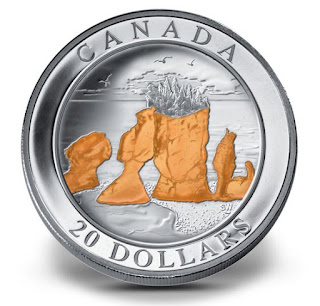Canada 20 Dollars Silver Coin 2004 The Hopewell Rocks, Natural Wonders
Canada's Natural Wonders series
The Hopewell Rocks Gold-Plated Proof is the fifth in the very popular six-coin Natural Wonders series.
Obverse: The amazing Hopewell Rocks are highlighted in 24-karat red-gold plating, in front of a beautiful seascape on the Bay of Fundy.
When glaciers from the last Ice Age began to melt 13,000 years ago, a valley filled with water. As the seawater rose, it began to move with the daily rhythm of the tides. Every time it flowed in and out of the valley, the water caressed the shoreline, filling the vertical cracks in the cliffs and carrying away bits of rock. After millennia, huge blocks of stone stood alone, separated from the shore. To this day, 200 billion tonnes of water continue to swirl around the base of these rocks, sculpting distinctive “flowerpot” shapes that draw visitors from around the world. Every day, the sea retreats from the Bay of Fundy (New Brunswick) to reveal a landscape of unimaginable artistry a magical place of ancient sculptures that are still incomplete. That’s because nature’s creation is always ongoing.
Reverse: Her Majesty, Queen Elizabeth II of England, in profile facing right. This portrait, the fourth effigy of the queen to appear on Canadian Coinage, was executed by the artist Susanna Blunt. The legend ELIZABETH II D. G. REGINA ("Elizabeth II, Queen by the Grace of God") and the date of issue also appear.
Mintage: 25000.
Composition: 99.99% pure silver.
Finish: proof.
Weight: 31.39 g.
Diameter: 38 mm.
Edge: serrated.
Face value: 20 Canadian Dollars.
Artist: Stan Witten (reverse).
Manufacturer: Royal Canadian Mint.
Purity Note: The Royal Canadian Mint refines the purest silver in the world. The RCM is also the only mint in the world to issue commemorative coins in a .9999 fineness. This one ounce silver proof is 99.99% pure!
Packaging: The coin is encapsulated inside a burgundy leatherette, clamshell-style presentation case, lined with black velvet and protected by a black outer box. An individually-numbered certificate of authenticity is included.
Hopewell Rocks
The Hopewell Rocks, also called the Flowerpots Rocks or simply The Rocks, are rock formations caused by tidal erosion in The Hopewell Rocks Ocean Tidal Exploration Site in New Brunswick. They stand 40–70 feet tall.
They are located on the shores of the upper reaches of the Bay of Fundy at Hopewell Cape near Moncton. Due to the extreme tidal range of the Bay of Fundy, the base of the formations are covered in water twice a day. However, it is possible to view the formations from ground level at low tide.
The formations consist of dark sedimentary conglomerate and sandstone rock. The large volume of water flowing in to and out of the Bay of Fundy modifies the landscape surrounding it. After the retreat of the glaciers in the region following the last ice age, surface water filtering through cracks in the cliff has eroded and separated the formations from the rest of the cliff face. Meanwhile, advancing and retreating tides and the associated waves have eroded the base of the rocks at a faster rate than the tops, resulting in their unusual shapes.
The vast sediment planes in the basin in Fundy supports a variety of biological productivity. Various shorebirds are often seen flocking to nest and feed in the area. Visitors are advised to stay for a full tidal cycle to get a full appreciation of the tides and formations. Although the tides vary from day to day, the high tide can be as high as 16 metres (52 ft) giving the Hopewell Rocks one of the highest average tides in the world.
On March 14, 2016, a part of one of the Hopewell Rocks, Elephant Rock, collapsed. Park officials said approximately 100 to 200 tonnes of rock fell to the ground. "Sometime after the tide went out this morning, a significant piece of Elephant Rock calved off, closing off a whole section or a whole passageway where we used to walk," said Kevin Snair, supervisor of interpretive services at the Hopewell Rocks.

